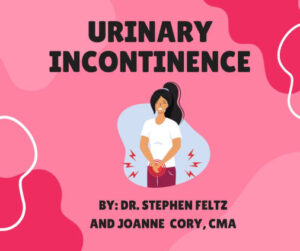 There are three main types of urinary incontinence or you may know it as urinary leakage.
There are three main types of urinary incontinence or you may know it as urinary leakage.
1. Stress incontinence occurs when the tissues around the urethra (the tube that leads from the bladder to the outside) weaken. Pressure on the bladder from coughing, sneezing, lifting, and exercise can allow urine to escape. This can vary from a drop or two to soaking a pad.
2. Urge incontinence occurs when the muscle of the bladder (detrusor muscle) is over active and contracts when you are not on the toilet. This creates a sense of urgency that can be so strong that you can’t control it and you may lose anywhere from a few drops of urine to actually emptying the contents of your bladder – wetting your pants.
3. Overflow incontinence occurs when the bladder doesn’t empty entirely when voiding leaving residual urine that builds up in the bladder causing the full bladder to “spill over”, resulting in a steady stream of small amounts. It is usually related to the bladder muscle not contracting well or an obstruction putting pressure on the urethra. This type of incontinence is not as common as the stress or urge incontinence.
The most common types are stress and urge and but you can have a mixed incontinence, which is a combination of two types of incontinence.
Incontinence in women is common but NOT normal. It is important to have your bladder properly evaluated when you first notice symptoms. Common causes such as pelvic organ prolapses, weakened pelvic floor muscles, ingestion of bladder irritants, weight gain, and smoking can be identified and treatment started. When found early, you can often start with conservative measures such as pelvic floor exercises, giving up caffeinated and carbonated beverages, weight loss and smoking cessation. Some women require more aggressive therapy such as medication, nerve stimulation, or even surgery.
If you have these symptoms give us a call today and schedule with any of our physicians. Dr. Steven Feltz has a focus on Urogynecology and Reconstructive Pelvic Surgery. Call us today at 515-288-3287 to schedule your appointment.
We are accepting new patients! To schedule an appointment with OBGYN Associates, call us at 515-288-3287.
DISCLAIMER: All information on this website is provided for informational purposes only and is not intended to be construed as medical advice. OBGYN Associates shall not be liable for any errors or inaccuracies contained herein, or any actions taken in reliance thereon.

There are three main types of urinary incontinence or you may know it as urinary leakage.
1. Stress incontinence occurs when the tissues around the urethra (the tube that leads from the bladder to the outside) weaken. Pressure on the bladder from coughing, sneezing, lifting, and exercise can allow urine to escape. This can vary from a drop or two to soaking a pad.
2. Urge incontinence occurs when the muscle of the bladder (detrusor muscle) is over active and contracts when you are not on the toilet. This creates a sense of urgency that can be so strong that you can’t control it and you may lose anywhere from a few drops of urine to actually emptying the contents of your bladder – wetting your pants.
3. Overflow incontinence occurs when the bladder doesn’t empty entirely when voiding leaving residual urine that builds up in the bladder causing the full bladder to “spill over”, resulting in a steady stream of small amounts. It is usually related to the bladder muscle not contracting well or an obstruction putting pressure on the urethra. This type of incontinence is not as common as the stress or urge incontinence.
The most common types are stress and urge and but you can have a mixed incontinence, which is a combination of two types of incontinence.
Incontinence in women is common but NOT normal. It is important to have your bladder properly evaluated when you first notice symptoms. Common causes such as pelvic organ prolapses, weakened pelvic floor muscles, ingestion of bladder irritants, weight gain, and smoking can be identified and treatment started. When found early, you can often start with conservative measures such as pelvic floor exercises, giving up caffeinated and carbonated beverages, weight loss and smoking cessation. Some women require more aggressive therapy such as medication, nerve stimulation, or even surgery.
If you have these symptoms give us a call today and schedule with any of our physicians. Dr. Steven Feltz has a focus on Urogynecology and Reconstructive Pelvic Surgery. Call us today at 515-288-3287 to schedule your appointment.
We are accepting new patients! To schedule an appointment with OBGYN Associates, call us at 515-288-3287.
DISCLAIMER: All information on this website is provided for informational purposes only and is not intended to be construed as medical advice. OBGYN Associates shall not be liable for any errors or inaccuracies contained herein, or any actions taken in reliance thereon.





Leave A Comment